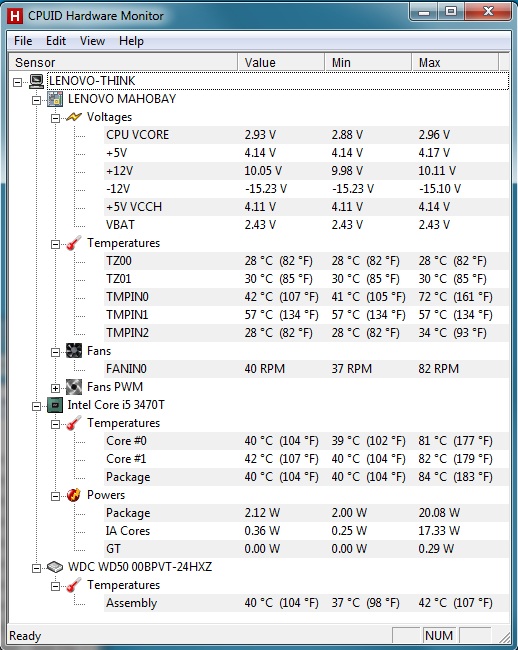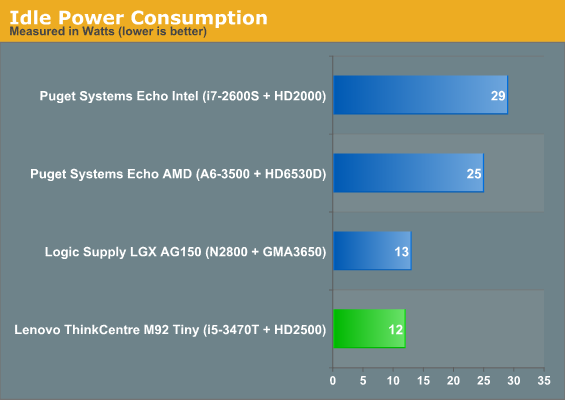Lenovo ThinkCentre M92 Tiny System Review: Pint-Sized Power
by Dustin Sklavos on August 17, 2012 12:00 AM EST- Posted in
- Systems
- Lenovo
- Mini ITX
- Ivy Bridge
- Enterprise
Build, Noise, Heat, and Power Consumption
I'll say this for Lenovo: whatever my complaints about the ThinkCentre M92 Tiny's default configuration (especially in regards to price), the chassis itself is well built. Lenovo has a pretty smart flow-through design that pulls in air through the front and exhausts it out of the back, and even under load the M92 Tiny is below 30dB. It also benefits from the USB 3.0 support integrated into Intel's 7 series chipsets.
.jpg)
On the other hand, the port selection on the back of the M92 Tiny may be a matter of some contention depending on your needs. I don't think anyone will complain about the additional two USB 3.0 ports on the back, but the lack of audio ports is unusual, and I personally feel like it may still be too soon to rely on DisplayPort as our sole digital output. In a perfect world we'd have a DVI port there, or maybe HDMI, but DVI ports are pretty big and I'm not sure exactly how Lenovo would've fit it in (above the VGA port maybe?). Thankfully Lenovo ships a DisplayPort-to-DVI dongle with the M92 Tiny.
However you feel about the choice of ports for the M92 Tiny, the cooling system is aces given how small the whole thing is.

The CPU runs a little toasty, but Ivy Bridge is prone to running hot to begin with. Given the way other vendors seem to be content to toe the line in regards to running Ivy's thermals right up to spec, I think you could reasonably argue Lenovo might have included an option for a 45-watt i5-3570T.


Power consumption is as you'd expect, pretty much as good as it gets short of going down to Atom. Under load the M92 Tiny isn't even stretching the limits of its 65W power supply, since these measurements were taken at the wall. At this point it's worth mentioning how remarkable it is that we're able to get this much performance out of this little power. It's true the i7-2600S in the Puget Systems Echo posts notable leads on Lenovo's system when threading comes into play, but it requires more than twice as much power to produce at most a 50% lead.


_thumb.jpg)
_thumb.jpg)
_thumb.jpg)
_thumb.jpg)
_thumb.jpg)
_thumb.jpg)








62 Comments
View All Comments
Crono - Friday, August 17, 2012 - link
I think the Dustin hit the nail on the head with the conclusion. The size and most of the specs are fine.But for me the biggest flaw with this system is the mechanical drive instead of an SSD.
I would expect an SSD even in a lower priced computer, but for $699? Flash storage is a must.
Samus - Friday, August 17, 2012 - link
Agreed. With the price of 128GB SSD's (<$100 retail) and the target audience for this machine (who will generally use only 40-60GB of storage) then pouring salt on the wound even further by considering the 500GB Scorpio costs about $50, Lenovo could have outfitted this machine with a SSD for <$50 more in materials. To top it off, being equiped with USB 3.0, IF more storage were needed, its obviously easy to add.Just a complete lapse in judgement on their part.
yyrkoon - Friday, August 17, 2012 - link
I do not agree about the SSD comment. Just because everyone under the sun wants one in this machine for that price.System integrators make money by building systems. Then adding a profit to the cost. Followed by support. Also, they possibly make commission when one of the trial apps they offer gets upgraded to a full version. This is how it has always been.
On top of this, the case probably cost a bundle to have designed, and made.
Does this mean I would buy this system as is ? No. While I can see justification for price. I would not spend this much money on this system. Simply, I can build my own similar system for a little more than half the cost. However, if something went wrong with the machine I built. I would get no on site support / repair. Then there is no telling if I would be able to find certain things as easily as Lenovo, The external brick PSU comes to mind. This is not to say it would be impossible, But there is a good chance that the PSU was also custom made specifically for this system.
So while I do agree with the original post here in that it is not enough value *for me*. I can see it being of enough value for people who want a small / efficient system. For general computing.
Before finishing though. 38W load power consumption is quite good. Albeit, with monitor not quite good enough. Sub 50W would be very exciting.
Samus - Monday, August 20, 2012 - link
You clearly know nothing about the corporate market, and I seriously question whether Lenovo does by offering such a configuration, either.Virtually all office machines should have 80-120GB SSD's, especially since they now cost roughly the same price as commonly equiped 500GB hard drives.
99% of corporate PC's I come across on a daily basis have <40GB used on the hard disk. Either all their data is small word/excel documents and some photo's, or all their data is on a server. Multi-user machines on a peer-to-peer network typically have people storing data on a NAS or their personal flash drives. Again, VERY little storage usage. Why equip a machine DESIGNED for this market with a 500GB drive where 460GB will remain free during its entire service duration?
Marlin1975 - Friday, August 17, 2012 - link
Problem is a Mech drive is very reliable and has more room per dollar.Yea there are plenty of good SSD's (Intel, Crucial, samsung, etc...) but even then they all have firmware that needs to be updated and updates means someone at the company has to do it, i.e. cost money, and makes it seem like the system is not reliable and could hurt sales in the future.
I think a faster 7200rpm drive would be better and also another stick of ram in it for dual channel, if its an option.
dijidiji - Friday, August 17, 2012 - link
If you build a test system on their website, you'll see that you can upgrade the drive to 7200rpm for 0 dollars and 0 cents.yyrkoon - Friday, August 17, 2012 - link
... and it will most certainly use more power. How much more I could not say exactly, Possibly 10W give or take.Samus - Monday, August 20, 2012 - link
Prove a mechanical drive with multiple moving parts and extreme heat/vibration sensitivity is more reliable than an SSD? Excluding some OCZ crap. Think Intel, Samsung, Crucial, companies with 0.0001% failure rates.I still haven't seen an Intel or Samsung SSD fail in 5 years.
Death666Angel - Tuesday, August 28, 2012 - link
You realize that even fully fledged 3.5" HDDs don't use 10W under load these days? The difference between 2.5" 5400 rpm and 7200 rpm is 1 or 2 W at most.know of fence - Friday, August 17, 2012 - link
For businesses and offices compatibility with XP is important still, while boot up times or app. launch times matter very little.I think a lot of people are forced to upgrade from mid-2000s office towers, to smaller efficient hardware, without having to give up their (no frills) working environment. That's why we see VGA and HDD, along with USB 3 and Display Port.